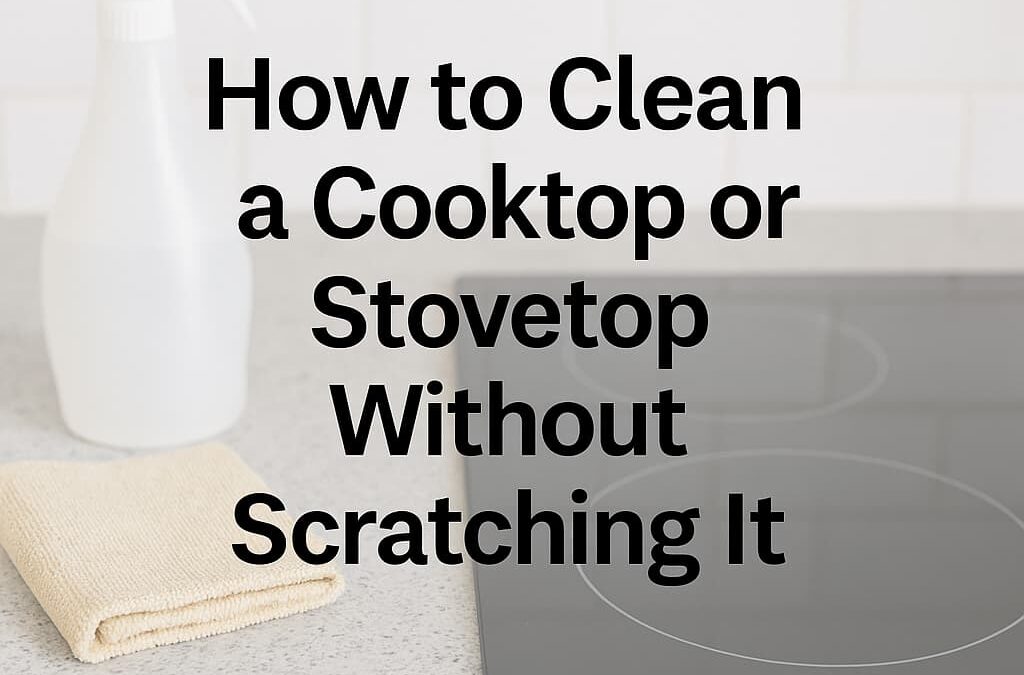Cooktops and stovetops are the workhorses of the kitchen. From boiling pasta to frying dinner, spills and splatters are inevitable. But cleaning them can feel like a battle — especially when dealing with burnt-on food or greasy residue. Scrubbing too hard or using the wrong tools can leave scratches that ruin the surface.
So how do you keep your cooktop sparkling without damage? The key is using the right cleaners and techniques for your surface type — whether glass, ceramic, stainless steel, or gas stovetops.
Key Takeaways
- Always let cooktops cool completely before cleaning.
- Use soft cloths, sponges, or scrapers designed for glass — never steel wool.
- Baking soda paste removes burnt food gently without scratching.
- Vinegar helps cut grease but avoid it on stone backsplashes.
- Regular wiping after cooking prevents tough stains from forming.
Why Do Cooktops Scratch So Easily?
Modern cooktops — especially glass and ceramic — are sleek but delicate. Scratches often happen because of:
- Abrasive pads (like steel wool)
- Harsh powders
- Sliding pots and pans across the surface
- Over-scrubbing baked-on spills
Once scratched, surfaces trap more dirt and grease, making cleaning harder. That’s why gentle but effective methods are best.
How Do You Clean a Glass or Ceramic Cooktop Without Scratching It?
Glass and ceramic cooktops are common in modern kitchens but show every spill.
Step-by-Step Safe Cleaning
- Wait until cool. Cleaning while hot risks burns and streaks.
- Wipe loose crumbs. Use a microfiber cloth.
- Apply baking soda paste. Mix baking soda with a few drops of water. Spread on burnt spots.
- Cover with warm, damp cloth. Let sit for 15 minutes to loosen grime.
- Wipe gently. Use a non-abrasive sponge or soft cloth.
- For stubborn spots. Use a plastic scraper made for glass stovetops.
- Polish. Finish with vinegar-water spray for shine.
👉 Avoid steel wool, scouring powders, or rough sponges.
How Do You Clean a Stainless Steel Cooktop Without Scratching?
Stainless steel is durable but prone to streaks and scratches.
Safe Method
- Wipe with dish soap + warm water using a microfiber cloth.
- For grease, spray vinegar-water solution and wipe with the grain.
- For stubborn spots, use a paste of baking soda + water. Rinse well.
- Dry with a clean towel to prevent watermarks.
👉 Always wipe with the grain to avoid visible scratches.
How Do You Clean a Gas Stovetop Without Scratching It?
Gas stoves have grates and burners that trap grease and food.
Steps
- Remove grates and soak in warm, soapy water.
- Wipe stovetop surface with mild dish soap and soft sponge.
- For burnt spots, use baking soda paste. Let sit 10 minutes before wiping.
- Rinse grates, scrub with a nylon brush if needed, and dry before reassembling.
👉 Avoid dragging grates across the surface to prevent scratches.
Which Tools Are Safe for Cooktop Cleaning?
| Tool | Safe/Unsafe | Notes |
|---|---|---|
| Microfiber cloths | ✅ Safe | Soft, non-abrasive |
| Non-scratch sponges | ✅ Safe | Choose labeled “non-abrasive” |
| Plastic scrapers | ✅ Safe | Ideal for glass/ceramic cooktops |
| Razor blade scrapers | ✅ Safe if used gently | Keep at 45° angle, only on flat glass |
| Steel wool | ❌ Unsafe | Leaves permanent scratches |
| Abrasive powders | ❌ Unsafe | Damage glossy finish |
Natural Cleaners for Stovetops (Scratch-Free)
- Baking Soda → Great for burnt food stains
- Vinegar Spray → Cuts grease and leaves shine
- Lemon Juice → Natural deodorizer, but avoid on stone nearby
- Hydrogen Peroxide (3%) → For stubborn gunk, mix with baking soda
💡 Always test homemade cleaners on a small area first.
What Mistakes Should You Avoid When Cleaning Cooktops?
- Cleaning while the surface is still hot.
- Using steel wool or metal scouring pads.
- Sprinkling dry baking soda and scrubbing hard.
- Dragging pots or pans instead of lifting.
- Leaving sugary spills (like caramel) too long — they can permanently damage glass cooktops.
FAQs
Can I use Windex on a glass cooktop?
Yes, for shine. But it won’t remove burnt food — use baking soda paste for that.
How do I remove burnt sugar from a cooktop?
Use a razor scraper gently at a 45° angle, then wipe with vinegar-water.
Can I use bleach on stovetops?
Avoid bleach on stainless steel and glass — it can damage finishes.
How often should I clean my cooktop?
Wipe daily after cooking, deep clean weekly for best results.
Quick Cooktop Cleaning Checklist
- Always cool before cleaning.
- Use microfiber cloths or non-abrasive sponges.
- Apply baking soda paste for burnt spots.
- Use plastic scrapers on glass, never steel wool.
- Wipe stainless steel with the grain.
- Clean grates weekly on gas stoves.
Final Thoughts
Keeping a cooktop spotless without scratches is all about balance. Use gentle cleaners like baking soda and vinegar, soft cloths, and plastic scrapers for tough spots. Avoid harsh pads or powders that damage the finish. With consistent care, your stovetop will stay shiny, smooth, and scratch-free for years.

As the chief content writer, Hassan Al Sarker works as a professional kitchen-based content creator at Kitchen Liker.
In addition to reviewing the content published on Kitchen Liker, he ensures that it is accurate, relevant, and helpful. As a result, all the reviews and information published at Kitchen Liker are neutral and userfriendly.
Hassan Al Sarker has a bachelor’s degree in Hotel and Tourism Management From the Newyork University. Before joining Kitchen Liker, he was a contributor at Kitchen Club, United States.

